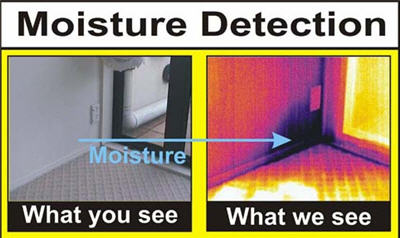What is Infrared?
By definition infrared is a type of electromagnetic radiation invisible to the human eye. The name incorporates a Latin term and means “below red.” Infrared light has wavelengths longer than those visible to humans. Other invisible wavelengths include X-rays, radio waves and microwaves. Infrared light tends to record the heat signature of an object or environment.
How would this benefit a building inspector?
An infrared camera is a diagnostic non-contact device that detects infrared energy (heat) and converts it into an electronic signal, which is then processed to produce a thermal image or video, on which you can perform temperature calculations. Heat sensed by an IR camera can be very precisely quantified, or measured, allowing you to not only monitor thermal performance, but also identify and evaluate the relative severity of heat-related problems.
What this means is, when properly trained an inspector can identify and determine what conditions may exist behind certain types of building materials (given the right conditions). For example, in a basement that is poorly insulated the camera will give off a distinct signature as seen below. The darker spots in the photo indicate low or missing insulation levels.

When moisture is present and in the process of evaporating the camera will aid the inspector by identifying variances in temperature that sometimes are not even visible. Moisture typically will have a dark signature like below. It is very important when moisture is concerned to verify this with a secondary moisture detection device such as a moisture meter. The first photo is a failed seal on the toilet which is allowing water to leak and damage the sub-floor. The second photo is moisture from a foundation leak which has been absorbed by the finished flooring.


Can Infrared see through walls?
One of the common misconceptions about Infrared is that it is like an x-ray machine and this is not the case. Infrared cameras cannot see through walls. Walls are usually insulated and thick enough that they can block infrared radiation. Infrared is merely a diagnostic aid. This is why the required training for the inspector is imperative to understand with certainty what the conditions may be. It is easy to make false observations, for example, electrically conductive materials will give off signatures similar to heat readings. These are actually reflected temperatures and often not even warm to touch. Different types of metals will require proper calibrations on your camera. The IR camera cannot tell the inspector if concealed mold is present. This determination would be merely from deductive reasoning based on current conditions. The photo below illustrates the different types of rays and how they are viewed through photography.

What are infrared cameras used for?
Infrared cameras have many applications in building sciences. It is used in electrical applications, energy audits, building inspections and many other instances. That is why it is important that the inspector utilizes an IR camera as part of every inspection, a thorough inspection cannot be performed without the use of Infrared.



